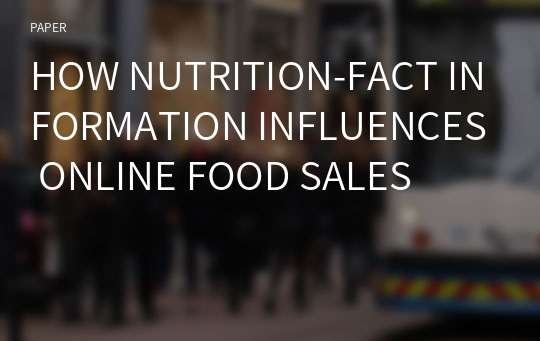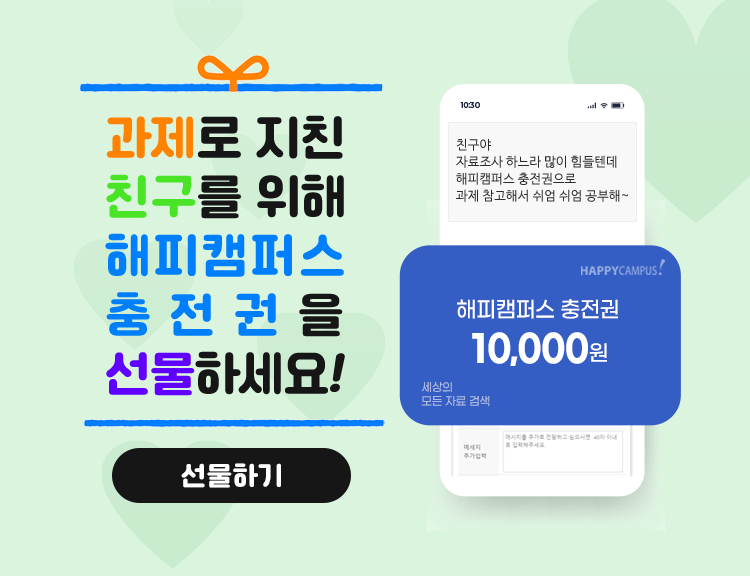HOW NUTRITION-FACT INFORMATION INFLUENCES ONLINE FOOD SALES
* 본 문서는 배포용으로 복사 및 편집이 불가합니다.
서지정보
ㆍ발행기관 : 글로벌지식마케팅경영학회(GFMC)
ㆍ수록지정보 : Global Marketing Conference
ㆍ저자명 : Peng Zou, Jingwen Liu, Yixin Li
ㆍ저자명 : Peng Zou, Jingwen Liu, Yixin Li
영어 초록
IntroductionOnline shopping has become an important part of people’s daily lives. The very nature of online shopping makes it unlikely for consumers to examine products with their senses (e.g., touch, smell) as they can do in offline stores. The consumer obtains information from a variety of online sources (sellers, other buyers, and third parties) to assess a product and make a purchase decision. This variety of online information (e.g., product description, reviews and ratings) informs and persuades consumers. While sellers’ decisions comprise most information displayed on their product’s website, other information is shown because consumers have a moral, ethical, and legal “right” to know (e.g., ingredients, weight, size) (Jacoby, Speller, & Berning, 1974).
Regarding the latter information, some countries (e.g., the U.S., China, Canada, the EU and India) have regulations that require pre-packaged food manufacturers to provide a nutrition-fact label and claims displaying standardized information on product packaging (Health Canada, 2010). We ask the following question to public policy makers and marketers: Should online pre-packaged food shops also need to present nutrition facts? There are two perspectives one might adopt regarding the array of information confronting online shoppers. The first perspective deals with human information processing. This position maintains that humans’ ability to assimilate and process information has finite limits during any given unit of time, and that once these limits are surpassed, behavior tends to become confused and dysfunctional (Miller, 1956; Driver & Streufert, 1969). Conceivably, such information overload might also occur in online shopping. Online shoppers often make their selections from a range of products, each with an array of information. Moreover, they make such purchase decisions within a relatively short time period.
An alternative perspective is that nutrition-fact information provides key cues for consumers to assess product quality in the online marketplace. Cues can be categorized as extrinsic or intrinsic to the product (Maheswaran & Chaiken, 1991; Anderson, 1981). Extrinsic cues are product-related attributes that can be altered whereas intrinsic cues are inherent to the product itself (e.g., ingredients) and cannot be easily altered (Rao & Monroe, 1988; Purohit & Srivastava, 2001). An online shopper's evaluation of a product is based upon both intrinsic and extrinsic cues. In the online shopping environment, few intrinsic cues are available to consumers and the disclosure of nutrition facts (an intrinsic product feature) can help to fill this gap.
Theoretical Development
The understanding of how nutrition information presentation influences online food sales is a substantial topic for both industry and academia. With the convenience of online shopping, the potential for food producers and retail stores to take their products online is enormous. eMarketer (2014) reports that online food and beverage purchases increased 15.2% in U.S. retail ecommerce sales, and that this trend will remain consistent. Online food shopping is extremely popular in China, with 92% of consumers purchasing food or beverages at least once a month (Weber Shandwick, 2014). Moreover, eMarketer (2016) reports that by 2020, one-fourth of China's online purchases will be made directly from foreign websites or from third-party platforms. Thus, it is important for other countries to learn about the Chinese market. Among these potential issues, whether nutrition-fact information affects consumer purchase decisions in the online shopping context remains unexplored. Nutrition-fact labels have proven to be useful cues for consumer purchasing decision in offline conditions (Shah, Bettman, Ubel, Keller, & Edell, 2014). However, researchers have been unable to determine the effects of nutrition information in online conditions with network virtualization (Mavlanova, Benbunan-Fich, & Koufaris, 2012) and information multiplicity. In addition, the nutrition information disclosed by online sellers may cue consumers to acquire healthy food. Previous research has found that when information pertaining to a food’s nutritional content is provided, less-healthy food tastes better (Raghunathan, Naylor, & Hoyer, 2006). This literature raises the issue of whether nutrition information is more effective for healthy or unhealthy products. In summary, we investigate the effect of nutrition-fact information on online food shopping. The research questions address: (1) whether and how nutrition-fact information influences food sales in online conditions; (2) how nutrition-fact information interacts with other online extrinsic cues (i.e., word of mouth and historical sales); and (3) whether nutrition-fact information is more effective for healthy or unhealthy products.
Research Design
We then address these issues using panel data collected from Taobao.com (the largest online shopping platform in China). We selected 45 days as our study period, and the sample comprised 273 sellers. In addition, we conduct an experiment using an eye-tracking system to test the necessity and helpfulness of nutrition-fact information.
Results and Conclusion
The results show that the nutrition-fact information has a significant impact on sales. More specifically, consumers are more likely to choose sellers with the nutrition-fact information, and the healthy (unhealthy) food with nutrition-fact information tends to attract more (fewer) purchase. In addition, our results reveal some interesting interactions between nutrition-fact information and other cues. Specifically, WOM and historical sales strengthen the sales impact of nutrition-fact information. Our eye-tracking experiment leads to several interesting results. First, consumers pay attention to nutrition-fact information and spend considerable time reading it. Second, a long fixation length on nutrition-fact information would reasonably increase sales.
This study makes several academic contributions. First, we extend the topic of nutrition information to an e-commerce context. Second, this is one of the first studies to examine the role of nutrition-fact information from an experimental perspective. Third, we supplement the findings of previous studies on the role of food type. This study also provides several practical implications. First, governments could require online sellers to reveal nutrition information in a truthful and detailed manner at the point of sale. In addition, labeling policies not only increase nutrition awareness and protect consumers, but they can also offer a profitable path for marketers. Second, sellers should design nutrition information and other cues strategies jointly. Third, compared with unhealthy food, nutrition-fact information is more effective for the purchase of healthy food. Sellers might be encouraged by this trend and consider more strategies to display nutrition-fact information on healthy food.
참고 자료
없음"Global Marketing Conference"의 다른 논문
 THE ROLES OF GREEN PACKAGING IN UGLY FOOD PURCHASE INTE..22페이지
THE ROLES OF GREEN PACKAGING IN UGLY FOOD PURCHASE INTE..22페이지 THE IMPACT OF INDUCED AWE ON ETHICAL TOURIST BEHAVIORS5페이지
THE IMPACT OF INDUCED AWE ON ETHICAL TOURIST BEHAVIORS5페이지 A BIBLIOMETRIC ANALYSIS OF SPIRITUAL TOURISM RESEARCH15페이지
A BIBLIOMETRIC ANALYSIS OF SPIRITUAL TOURISM RESEARCH15페이지 SOCIAL NETWORK ANALYSIS AND RESPONSE TIME TESTING: CONS..11페이지
SOCIAL NETWORK ANALYSIS AND RESPONSE TIME TESTING: CONS..11페이지 THE EFFECTS OF PARA-SOCIAL INTERACTION ON ONLINE CELEBR..3페이지
THE EFFECTS OF PARA-SOCIAL INTERACTION ON ONLINE CELEBR..3페이지 THE INFLUENCE OF OPINION LEADERS ON DAILY DEALS USER’S ..3페이지
THE INFLUENCE OF OPINION LEADERS ON DAILY DEALS USER’S ..3페이지 HOW IMMERSIVE RETAILING AFFECTS CONSUMERS’ URGE TO BUY:..6페이지
HOW IMMERSIVE RETAILING AFFECTS CONSUMERS’ URGE TO BUY:..6페이지 KEY TO SUPERSTARDOM IN A GLOBALISED MARKET: THE ROLE OF..6페이지
KEY TO SUPERSTARDOM IN A GLOBALISED MARKET: THE ROLE OF..6페이지 A POST-PANDEMIC LOOK AT TOURISTS’ PERCEIVED COOLNESS OF..4페이지
A POST-PANDEMIC LOOK AT TOURISTS’ PERCEIVED COOLNESS OF..4페이지 EXTRACTING OFFLINE RETAIL SHOPPING PATTERNS: OLLABORATI..5페이지
EXTRACTING OFFLINE RETAIL SHOPPING PATTERNS: OLLABORATI..5페이지

























